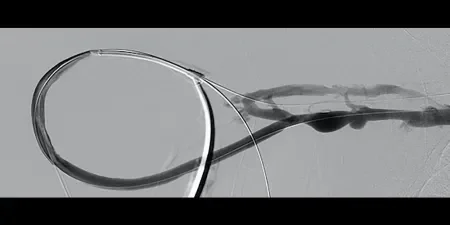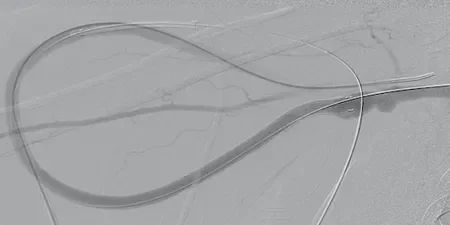Treating a thrombosed arteriovenous (AV) access graft with the GORE® VIABAHN® Endoprosthesis

Challenge
- 77-year-old female with end-stage renal disease on hemodialysis via a right upper extremity axillary artery to axillary vein ePTFE loop graft
- Presented after unsuccessful attempt at dialysis due to an occluded graft
- Relevant patient history:
- Access was created four months prior to presentation
- Venogram performed two months prior to presentation for pulsatility and recirculation demonstrated venous anastomotic tenosis, for which drug-eluting balloon venoplasty was performed
Image: Balloon angioplasty during clot maceration of a thrombosed upper arm graft reveals tight stricture at the venous anastomosis. The same lesion was previously treated two months prior.
Images courtesy of Thomas Ward, MD. Used with permission.

Procedure
- Initial ultrasound images demonstrated the length of the graft to be occluded. Antegrade and retrograde access was obtained.
- Pharmacological thrombolysis was performed with 4 mg tPA followed by balloon maceration across the length of the graft
- Contrast was injected via the antegrade sheath, demonstrating persistent moderate stenosis
- Given short-term recurrence and graft occlusion, an 8 mm x 7.5 cm GORE® VIABAHN® Endoprosthesis was deployed to treat the recurrent venous anastomotic stenosis
Image: Persistent stenosis at the venous anastomosis after balloon angioplasty
Images courtesy of Thomas Ward, MD. Used with permission.

Result
- Completion AV graft venogram demonstrated the graft and venous outflow stent to be widely patent
- A brisk thrill was palpated
- Patient had successful hemodialysis immediately following the procedure and dialysis access circuit remains patent
Image: Brisk thrill re-established after placement of 8 mm x 7.5 cm GORE® VIABAHN® Endoprosthesis
Images courtesy of Thomas Ward, MD. Used with permission.
Case Takeaways
- The GORE® VIABAHN® Endoprosthesis remains an excellent option for percutaneous revision of venous anastomotic stenosis in patients with a prosthetic hemodialysis graft
- In this patient with short-term recurrent stenosis after drug-eluting balloon venoplasty, use of the GORE® VIABAHN® Endoprosthesis aided in re-establishing access circuit patency
The outcomes and observations reported are based on individual case experience and the patients treated. The steps described here may not be complete, and are not intended to be a replacement for the Instructions for Use or the education, training and professional judgment of Healthcare Providers. Healthcare Providers remain solely responsible for making decisions about patient care and the use of medical technologies.
Refer to Instructions for Use at eifu.goremedical.com for complete description of all indications, warnings, precautions and contraindications for the markets where this product is available.